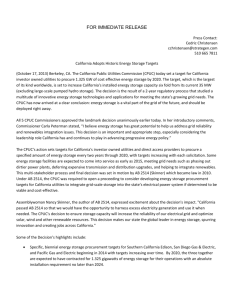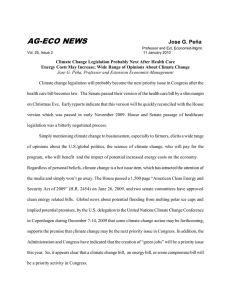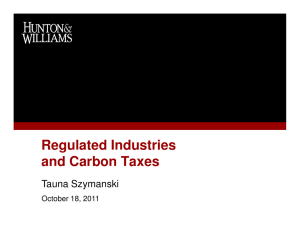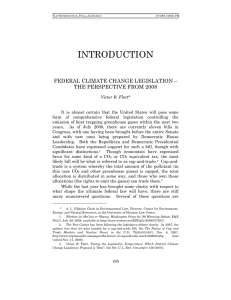CPUC ISSUES PROPOSAL ON USE OF REVENUE FROM SALE OF
advertisement
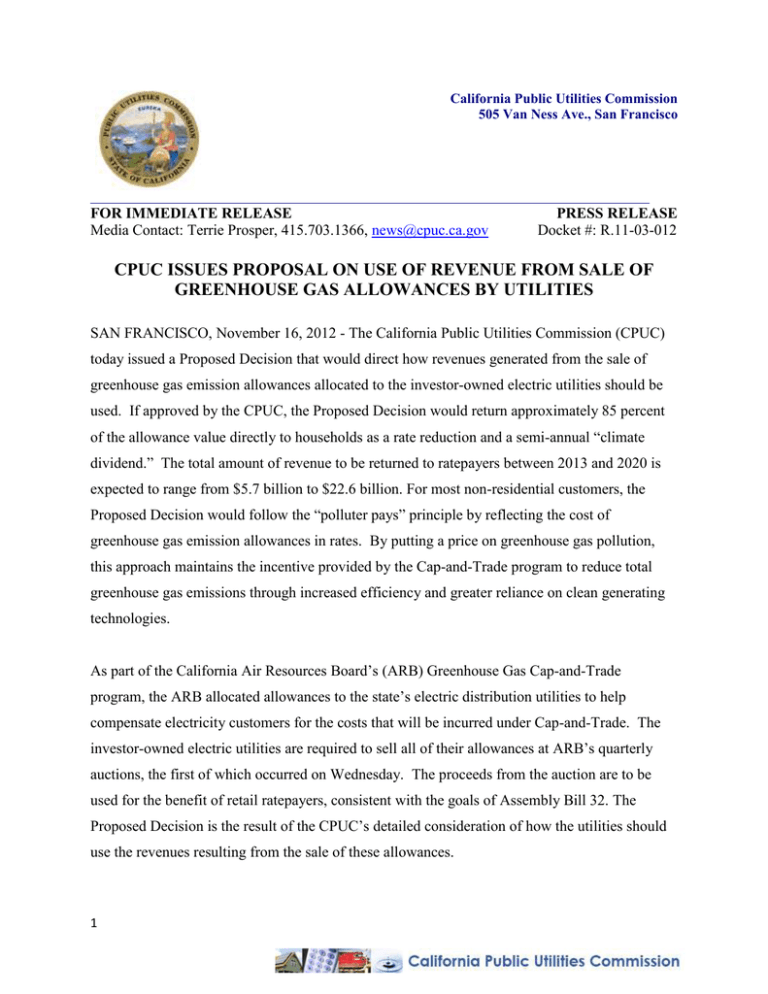
California Public Utilities Commission 505 Van Ness Ave., San Francisco _________________________________________________________________________________ FOR IMMEDIATE RELEASE Media Contact: Terrie Prosper, 415.703.1366, news@cpuc.ca.gov PRESS RELEASE Docket #: R.11-03-012 CPUC ISSUES PROPOSAL ON USE OF REVENUE FROM SALE OF GREENHOUSE GAS ALLOWANCES BY UTILITIES SAN FRANCISCO, November 16, 2012 - The California Public Utilities Commission (CPUC) today issued a Proposed Decision that would direct how revenues generated from the sale of greenhouse gas emission allowances allocated to the investor-owned electric utilities should be used. If approved by the CPUC, the Proposed Decision would return approximately 85 percent of the allowance value directly to households as a rate reduction and a semi-annual “climate dividend.” The total amount of revenue to be returned to ratepayers between 2013 and 2020 is expected to range from $5.7 billion to $22.6 billion. For most non-residential customers, the Proposed Decision would follow the “polluter pays” principle by reflecting the cost of greenhouse gas emission allowances in rates. By putting a price on greenhouse gas pollution, this approach maintains the incentive provided by the Cap-and-Trade program to reduce total greenhouse gas emissions through increased efficiency and greater reliance on clean generating technologies. As part of the California Air Resources Board’s (ARB) Greenhouse Gas Cap-and-Trade program, the ARB allocated allowances to the state’s electric distribution utilities to help compensate electricity customers for the costs that will be incurred under Cap-and-Trade. The investor-owned electric utilities are required to sell all of their allowances at ARB’s quarterly auctions, the first of which occurred on Wednesday. The proceeds from the auction are to be used for the benefit of retail ratepayers, consistent with the goals of Assembly Bill 32. The Proposed Decision is the result of the CPUC’s detailed consideration of how the utilities should use the revenues resulting from the sale of these allowances. 1 The Proposed Decision establishes several primary policy objectives to guide the use of the allowance revenues. These primary objectives are to: Preserve the carbon pollution price signal in electricity rates; Ensure that economic activity does not shift to other states and countries as a result of the Cap-and-Trade program; Reduce adverse outcomes on low income households; and, Maintain competitive neutrality among the utilities and Community Choice energy programs and Direct Access providers. The Proposed Decision finds that, in general, electricity rates should reflect the cost of carbon, as determined by the price of emission allowances sold in the Cap-and-Trade program. Preserving the carbon price signal is critical to providing appropriate incentives for businesses and individuals to reduce greenhouse gas emissions when making decisions regarding their energy use. However, in some circumstances, other important factors need to be considered. Following an extensive, stakeholder driven process, the Proposed Decision would allocate the revenues to each of the uses described below. First, to ensure the program does not disadvantage California industries, the Proposed Decision directs the investor-owned utilities to return allowance revenues to businesses operating in industries identified by ARB as emissions-intensive and trade-exposed. These businesses emit large amounts of greenhouse gas emissions and operate in competitive markets. This allocation of revenue is expected to cover the majority of the Cap-and-Trade-related costs these industries will experience in electricity rates while preserving incentives for these entities to reduce their emissions. The Proposed Decision also commits to consider in a follow-up process expanding the list of eligible industries to include trade-exposed entities that, while not emissions-intensive, face substantial indirect Cap-and-Trade costs through electricity purchases. Second, consistent with the direction provided by Senate Bill 1018, a bill that was attached to this year’s state budget, the Proposed Decision directs the investor-owned utilities to use allowance revenue to offset the Cap-and-Trade costs in small business electricity rates. Over the 2013-2020 period, the electricity rates small businesses are subject to will gradually rise to reflect the cost of carbon. This is intended to enable small businesses to adjust to the Cap-andTrade program through investments in energy efficiency, operational improvements, and clean 2 energy technologies. The Proposed Decision defines qualifying small businesses as any nonresidential customer – including agriculture, nonprofits, and others – that consumes less than 20 kilowatts of power. A proposal attached to the Proposed Decision sets forth a preliminary formula for revenue distribution to small businesses that will be further refined via a subsequent decision following a public workshop process. All of the remaining allowance revenue would be returned to residential customers, through two mechanisms. First, the Proposed Decision directs the use of the allowance revenue to fully mitigate the carbon costs that would otherwise be reflected in residential rates. While not in keeping with the general preference to preserve the carbon pollution price signal, in the case of the three large investor-owned utilities (Pacific Gas and Electric Company, Southern California Edison, and San Diego Gas & Electric), the Proposed Decision finds that an exception is warranted given the tiered structure of residential rates, which due to statutory constraints prevents carbon costs associated with residential consumption from being passed through to lower-tiers. Including the carbon cost only in upper-tier rates would further exacerbate the large gap that has developed between lower and upper-tier rates. The Proposed Decision finds that including additional carbon costs resulting from the Cap-and-Trade program in upper-tier rates would be unfair to customers with consumption in the upper tiers. After using revenues for compensating emissions-intensive, trade exposed-industries and offsetting the carbon costs in small business and residential rates, the remaining revenues would be given to residential customers as an equal semi-annual bill credit for each residential account. This “climate dividend” is intended to help offset any increases in the costs of goods and services that may result from the Cap-and-Trade program. In essence, under the compensation framework envisioned by the Proposed Decision, households will be paid by polluters for the right to emit greenhouse gases. This framework holds entities to account for their contributions to climate change, while limiting the impact of the Cap-and-Trade program on household budgets. The vote on the Proposed Decision is currently scheduled for December 20, 2012. 3 Members of the public can comment on the Proposed Decision by contacting the CPUC’s Public Advisor’s Office at 415-703-2074 or 866-849-8390 (TTY 866-836-7825) or public.advisor@cpuc.ca.gov or CPUC Public Advisor, 505 Van Ness Avenue, Room 2103, San Francisco, CA 94102. Please reference proceeding number R.11-03-012. The Proposed Decision is available at http://docs.cpuc.ca.gov/PublishedDocs/Efile/G000/M031/K744/31744787.PDF. For more information on the CPUC, please visit www.cpuc.ca.gov. ### 4
